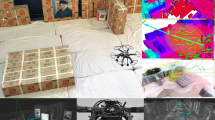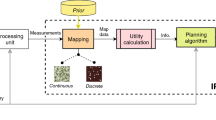Abstract
This paper discusses a collaborative air-ground team of autonomous vehicles for exploring and navigating outdoors within an unknown environment. A custom multi-rotor equipped with onboard downward facing stereo cameras flies over an unknown environment capturing imagery and reconstructing a height map of the ground surface online. Together with a simple terrain classifier, this height map is used to detect obstacles and estimate navigation costs for a Clearpath Robotics Jackal. Given a user defined goal, an online exploration algorithm automatically directs the aerial vehicle to expand the frontiers of the map until a path for the ground vehicle from the current position to the goal is discovered. Simultaneously, this algorithm directs the ground vehicle to execute partial paths to make progress towards the goal before a complete path has been discovered. Aside from the trajectory execution and the state estimation for the unmanned ground vehicle and the graphical interface for the operator, the online exploration algorithm and reconstruction all run onboard the UAV by taking advantage of the graphics processing unit (GPU) computing capabilities of the Nvidia TX2 for both stereo calculations and map construction. This paper presents the improvements made to an existing multi-robot system, the mapping and exploration algorithms. Finally, this paper discusses both simulation and hardware experiments conducted to validate the behavior of the exploration algorithm.
Similar content being viewed by others
Explore related subjects
Discover the latest articles and news from researchers in related subjects, suggested using machine learning.Data Availability
Data collected and used in this publication is available upon written request to Kevin Kochersberger at Virginia Tech
Code Availability
The software referenced in this publication is available upon written request to Kevin Kochersberger at Virginia Tech
References
Bachrach, A., He, R., Roy, N.: Autonomous flight in unknown indoor environments. Int. J. Micro Air Vehicles 1(4), 217–228 (2009). https://doi.org/10.1260/175682909790291492
Bentley, J.L.: Multidimensional binary search trees used for associative searching. Communications of the ACM 18(9), 509–517 (1975)
Burgard, W., Moors, M., Stachniss, C., Schneider, F.E.: Coordinated multi-robot exploration. IEEE Trans. Robot. 21(3), 376–386 (2005). https://doi.org/10.1109/TRO.2004.839232
Cesare, K., Skeele, R., Hollinger, G.: Multi-uav exploration with limited communication and battery. In: 2015 IEEE International Conference on Robotics and Automation (ICRA), pp. 2230–2235 (2015). https://doi.org/10.1109/ICRA.2015.7139494
Davuluri, P., Chen, C.H.: Radio frequency interference due to usb3 connector radiation. In: 2013 IEEE International Symposium on Electromagnetic Compatibility, pp. 632–635. IEEE (2013)
Donnelly, J.J.: Semi-dense stereo reconstruction from aerial imagery for improved obstacle detection. Master’s thesis, Virginia Tech (2019)
(FEMA), B.B.: Debris field in oklahoma (2008). https://commons.wikimedia.org/wiki/File:FEMA_-_35225_-_Debris_field_in_Oklahoma.jpg. Accessed 3 Jul 2019
Ferranti, E., Trigoni, N., Levene, M.: Brick mortar: an on-line multi-agent exploration algorithm. In: Proceedings 2007 IEEE International Conference on Robotics and Automation, pp. 761–767 (2007). https://doi.org/10.1109/ROBOT.2007.363078
González-Baños, H.H., Latombe, J.C.: Navigation strategies for exploring indoor environments. Int. J. Rob. Res. 21(10–11), 829–848 (2002). https://doi.org/10.1177/0278364902021010834
Haubeck, K., Prinz, T.: A uav-based low-cost stereo camera system for archaeological surveys—experiences from doliche (turkey). Int. Arch. Photogramm. Remote Sens. Spat. Inf. Sci pp. 195–200 (2013)
Hood, S., Benson, K., Hamod, P., Madison, D., O’Kane, J.M., Rekleitis, I.: Bird’s eye view: Cooperative exploration by ugv and uav. In: 2017 International Conference on Unmanned Aircraft Systems (ICUAS), pp. 247–255 (2017). https://doi.org/10.1109/ICUAS.2017.7991513
Juárez, D.H., Chacón, A., Espinosa, A., Vázquez, D., Moure, J.C., López, A.M.: Embedded real-time stereo estimation via semi-global matching on the GPU. In: International Conference on Computational Science 2016, ICCS 2016, 6-8 June 2016, San Diego, California, USA, Procedia Computer Science, vol. 80, pp. 143–153 (2016). https://doi.org/10.1016/j.procs.2016.05.305
Juliá, M., Gil, A., Reinoso, O.: A comparison of path planning strategies for autonomous exploration and mapping of unknown environments. Auton. Robot. 33(4), 427–444 (2012). https://doi.org/10.1007/s10514-012-9298-8
Kalra, N., Ferguson, D., Stentz, A.: Hoplites: A market-based framework for planned tight coordination in multirobot teams. In: Proceedings of the 2005 IEEE International Conference on Robotics and Automation, pp. 1170–1177 (2005). https://doi.org/10.1109/ROBOT.2005.1570274
Kim, J.H., Kwon, J.W., Seo, J.: Multi-uav-based stereo vision system without gps for ground obstacle mapping to assist path planning of ugv. Electron. Lett. 50(20), 1431–1432 (2014)
Kim, P., Price, L.C., Park, J., Cho, Y.K.: Uav-ugv cooperative 3d environmental mapping. In: ASCE International Conference on Computing in Civil Engineering 2019American Society of Civil Engineers (2019)
LaValle, S.M.: Planning Algorithms. Cambridge University Press, New York, NY, USA (2006)
Miki, T., Khrapchenkov, P., Hori, K.: Uav/ugv autonomous cooperation: Uav assists ugv to climb a cliff by attaching a tether. In: 2019 International Conference on Robotics and Automation (ICRA), pp. 8041–8047. IEEE (2019)
Milella, A., Reina, G., Foglia, M.M.: A multi-baseline stereo system for scene segmentation in natural environments. In: 2013 IEEE Conference on Technologies for Practical Robot Applications (TePRA), pp. 1–6. IEEE (2013)
Peterson, J., Chaudhry, H., Abdelatty, K., Bird, J., Kochersberger, K.: Online aerial terrain mapping for ground robot navigation. Sensors 18(2), 630 (2018)
Rovira-Más, F., Wang, Q., Zhang, Q.: Design parameters for adjusting the visual field of binocular stereo cameras. Biosyst. Eng. 105(1), 59–70 (2010)
Salas, W.L., Valentín-Coronado, L.M., Becerra, I., Ramírez-Pedraza, A.: Collaborative object search using heterogeneous mobile robots. In: 2021 IEEE International Autumn Meeting on Power, Electronics and Computing (ROPEC), vol. 5, pp. 1–6 (2021). https://doi.org/10.1109/ROPEC53248.2021.9668148
Schneider, J., Eling, C., Klingbeil, L., Kuhlmann, H., Förstner, W., Stachniss, C.: Fast and effective online pose estimation and mapping for uavs. In: 2016 IEEE International Conference on Robotics and Automation (ICRA), pp. 4784–4791. IEEE (2016)
Shim, D., Chung, H., Kim, H.J., Sastry, S.: Autonomous exploration in unknown urban environments for unmanned aerial vehicles. IEEE Robotics & Automation Magazine 13 (2005). https://doi.org/10.2514/6.2005-6478
Umari, H., Mukhopadhyay, S.: Autonomous robotic exploration based on multiple rapidly-exploring randomized trees. In: 2017 IEEE/RSJ International Conference on Intelligent Robots and Systems (IROS), pp. 1396–1402 (2017). https://doi.org/10.1109/IROS.2017.8202319
Warren, M., McKinnon, D., Upcroft, B.: Online calibration of stereo rigs for long-term autonomy. In: 2013 IEEE International Conference on Robotics and Automation, pp. 3692–3698. IEEE (2013)
Yamauchi, B.: A frontier-based approach for autonomous exploration. In: In Proceedings of the IEEE International Symposium on Computational Intelligence, Robotics and Automation, pp. 146–151 (1997)
Funding
This work was funded through the National Science Foundation I/UCRC Center for Unmanned Aircraft Systems Phase II Site Addition, Award No. 1650465.
Author information
Authors and Affiliations
Contributions
KK, AW, JP, and JD conceived this research; AW, JP, JD, and SC contributed software to this research; AW, JP, JD, and SC performed experiments and analysis; AW, JP, and KK wrote the paper and participated in the revisions of it.
Corresponding author
Ethics declarations
Conflicts of Interest
The authors declare that they have no conflict of interest.
Additional information
Publisher’s Note
Springer Nature remains neutral with regard to jurisdictional claims in published maps and institutional affiliations.
This work was funded through the National Science Foundation I/UCRC Center for Unmanned Aircraft Systems Phase II Site Addition, Award No. 1650465. The Jackal ground robot was graciously loaned by the Army Research Laboratory for these experiments.
Appendix A: Simulation Environment Diagrams
Appendix A: Simulation Environment Diagrams
Rights and permissions
Springer Nature or its licensor holds exclusive rights to this article under a publishing agreement with the author(s) or other rightsholder(s); author self-archiving of the accepted manuscript version of this article is solely governed by the terms of such publishing agreement and applicable law.
About this article
Cite this article
Wagner, A., Peterson, J., Donnelly, J. et al. Online Aerial 2.5D Terrain Mapping and Active Aerial Vehicle Exploration for Ground Robot Navigation. J Intell Robot Syst 106, 58 (2022). https://doi.org/10.1007/s10846-022-01751-9
Received:
Accepted:
Published:
DOI: https://doi.org/10.1007/s10846-022-01751-9








